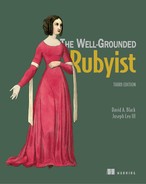0%
36Chapters
0-1Hours read
0kTotal Words
Table of Contents
- Copyright
- Brief Table of Contents
- Table of Contents
- Praise for the Second Edition
- Preface
- Acknowledgments
- About this book
- About the authors
- About the cover illustration
- Part 1. Ruby foundations
- Part 2. Built-in classes and modules
- Chapter 7. Built-in essentials
- Chapter 8. Strings, symbols, and other scalar objects
- Chapter 9. Collection and container objects
- Chapter 10. Collections central: Enumerable and Enumerator
- 10.1. Gaining enumerability through each
- 10.2. Enumerable Boolean queries
- 10.3. Enumerable searching and selecting
- 10.4. Element-wise enumerable operations
- 10.5. Relatives of each
- 10.6. The map method
- 10.7. Strings as quasi-enumerables
- 10.8. Sorting enumerables
- 10.9. Enumerators and the next dimension of enumerability
- 10.10. Enumerator semantics and uses
- 10.11. Enumerator method chaining
- 10.12. Lazy enumerators
- Summary
- Chapter 11. Regular expressions and regexp-based string operations
- 11.1. What are regular expressions?
- 11.2. Writing regular expressions
- 11.3. Building a pattern in a regular expression
- 11.4. Matching, substring captures, and MatchData
- 11.5. Fine-tuning regular expressions with quantifiers, anchors, and modifiers
- 11.6. Converting strings and regular expressions to each other
- 11.7. Common methods that use regular expressions
- Summary
- Chapter 12. File and I/O operations
- Part 3. Ruby dynamics
- Index
- List of Figures
- List of Tables
- List of Listings
